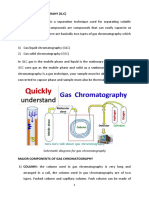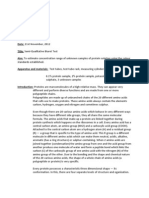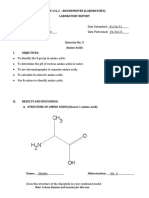Introduction: (Summary of Content That Will Be Explained in Detail by Group 1)
Introduction: (Summary of Content That Will Be Explained in Detail by Group 1)
Uploaded by
rajesh_juriaCopyright:
Available Formats
Introduction: (Summary of Content That Will Be Explained in Detail by Group 1)
Introduction: (Summary of Content That Will Be Explained in Detail by Group 1)
Uploaded by
rajesh_juriaOriginal Title
Copyright
Available Formats
Share this document
Did you find this document useful?
Is this content inappropriate?
Copyright:
Available Formats
Introduction: (Summary of Content That Will Be Explained in Detail by Group 1)
Introduction: (Summary of Content That Will Be Explained in Detail by Group 1)
Uploaded by
rajesh_juriaCopyright:
Available Formats
Introduction: (summary of content that will be explained in detail by group 1) Amino acids contain an amine functional group as well
n a carboxylic functional group Both attached to the same carbon atom they are known as 2-amino acids or -amino acids There are 20 such 2-amino acids that occur naturally and they are the building blocks of proteins Proteins are large macromolecules made up of chains of 2-amino acids The amino acids bond to each other through condensation reactions that result in polypeptides (term used to refer to 4 or more amino acids that are bonded together) After the condensation reaction, only residue of the amino acid remains which join together in a bond referred to as a peptide bond or an amide link Each protein contains a fixed number of amino acid residues that are connected together in a strict sequence that is referred to as the primary structure of the protein.
Protein Analysis: The 2 methods of protein analysis we will be explaining, namely paper chromatography and electrophoresis, can be used to determine the primary structure of a protein. In both methods the protein first undergoes hydrolysis by hydrochloric acid to release the amino acids that will be used for primary structure identification. Paper Chromatography: is a technique that is used to separate and identify substances that are or can be colored After the hydrolyzed protein releases various amino acids, a small sample of an unknown amino acid is placed at the bottom of the chromatographic paper Several samples of known amino acids can be placed alongside The paper is then placed in a solvent which rises up the paper due to capillary action. As the solvent meets the samples, the different samples of amino acids partition themselves between the solvent and the paper to different extent s and move up the paper at different rates. When the solvent has nearly reached the top, the paper is removed from the tank, dried and sprayed with an organic dye to develop the chromatogram by coloring the acids
The position of the spots of different samples, which becomes clearly visible due to the sprayed paper, can then be compared and the sample can be identified based on how much it has moved in relation to the known amino acid samples. This is movement in the position of the sample is referred to as the retention factor (defined as the ratio between the distance travelled by the sample and the distance travelled by the solvent, denoted as Rf) If samples of known amino acids are not available then the retention factor can be measured and compared to the retention factors of known amino acids in order to identify it The few real life instance where this technique is used, most commonly 2-dimensional chromatography is used which involves using two solvents and rotating the paper 90 in between This is more commonly used because it is possible for 2 acids to have the same retention in one solvent and different in another and to ensure that there is different retention obtained for all samples, 2-dimensional chromatography is used Similar compounds have the tendency to have similar retention hence using 2 solvents in 2-dimensional chromatography gives a better probability of obtaining a different retention value Hence this method is useful for separating complex mixtures of similar compounds which is true in the case of amino acids because they are essentially long chains of similar compounds. Paper chromatography has largely been replaced by thin layer chromatography in todays world. However this technique s still great because it is efficient, requires very small samples and the retention values for many substance are known through testing which makes the few unknown substances relatively easy to identify. The secondary structure of the protein, which describes the way in which the chain of amino acids folds itself due to intermolecular hydrogen bonding, can be confirmed using a process called X-ray crystallography.
You might also like
- Project Schedule - Construction of DamDocument1 pageProject Schedule - Construction of Damdupe2010100% (3)
- Photosynthesis: Pigment Separation, Starch Production and CO2 UptakeDocument10 pagesPhotosynthesis: Pigment Separation, Starch Production and CO2 UptakeJim Goetz100% (3)
- Identification of A Dipeptide UnknownDocument13 pagesIdentification of A Dipeptide UnknownVero Herrera CaroNo ratings yet
- Precalculus Tradler CarleyDocument425 pagesPrecalculus Tradler CarleyAlex Dorosh100% (1)
- Paper ChromatographyDocument6 pagesPaper ChromatographyManohar PattarNo ratings yet
- Exp 9 AnaDocument8 pagesExp 9 AnaAin Ain sofiNo ratings yet
- Identification of Amino Acids-Paper ChromatographyDocument9 pagesIdentification of Amino Acids-Paper ChromatographySharanya Srinivasan50% (2)
- Exp 3 Chromatographic Analysis of Peptide Hydrolysate PDFDocument5 pagesExp 3 Chromatographic Analysis of Peptide Hydrolysate PDFIsabel Joice EnriquezNo ratings yet
- Experiment 9: Separation of Amino Acid Mixture by Paper ChromatographyDocument8 pagesExperiment 9: Separation of Amino Acid Mixture by Paper Chromatographyfilzah haziqahNo ratings yet
- UV ApplicationDocument24 pagesUV ApplicationPratik KulkarniNo ratings yet
- Experiment 9 Separation of Amino Acid Mixture by PDocument6 pagesExperiment 9 Separation of Amino Acid Mixture by PNur AsyikinNo ratings yet
- 1.6 Analytical TechniquesDocument12 pages1.6 Analytical TechniquesMûhd AïZām ÄhmâdNo ratings yet
- 5 ChromatographyDocument7 pages5 ChromatographyAntonio CharismaNo ratings yet
- Paper ChromatographyDocument5 pagesPaper Chromatographys8903082No ratings yet
- Chromatography of Amino Acids Lab ReportDocument2 pagesChromatography of Amino Acids Lab ReportAjagwu EustaceNo ratings yet
- Spectrometric Determination of The Acid Dissociation Constant of Methyl RedDocument11 pagesSpectrometric Determination of The Acid Dissociation Constant of Methyl Redエンパーラナー カイザー ニロNo ratings yet
- Spectrophotometric Determination of Protein' ReportDocument4 pagesSpectrophotometric Determination of Protein' ReportAhmad Nabaz Khalil HamasalihNo ratings yet
- Separation and Identification of Amino Acids Present in Casein by Paper Chromatography andDocument8 pagesSeparation and Identification of Amino Acids Present in Casein by Paper Chromatography andblaire syNo ratings yet
- FS10 Lesson 1 LContentDocument17 pagesFS10 Lesson 1 LContentparikshityadav71No ratings yet
- Separation and Identification of Myoglobin by Paper Chromatography and Protein Assay by Bradford MethodDocument6 pagesSeparation and Identification of Myoglobin by Paper Chromatography and Protein Assay by Bradford MethodJason Montesa100% (1)
- Paper Aminoácidos TradDocument6 pagesPaper Aminoácidos TradDiana G RoseroNo ratings yet
- Kyte DoolitleDocument28 pagesKyte DoolitleGeorgia ItalpNo ratings yet
- TLC Lab ReportDocument5 pagesTLC Lab ReportJoão Paulo Toledo100% (4)
- Chromatography NotesDocument25 pagesChromatography NotesGeetha AnjaliNo ratings yet
- Protein EstimationDocument6 pagesProtein EstimationSTUTI MATHURNo ratings yet
- Discussion 5.1 Methods To Characterize Proteins and Their Advantages and Disadvantages Liquid Chromatography-Mass Spectrometer/ Mass Spectrometer (LC-MS/MS)Document5 pagesDiscussion 5.1 Methods To Characterize Proteins and Their Advantages and Disadvantages Liquid Chromatography-Mass Spectrometer/ Mass Spectrometer (LC-MS/MS)Sherry LauNo ratings yet
- Practical Biochemistry (STBP2012) : Experiment 3: Purification & Characterization Of α -Lactalbumin, A Milk ProteinDocument20 pagesPractical Biochemistry (STBP2012) : Experiment 3: Purification & Characterization Of α -Lactalbumin, A Milk ProteinfaizzudDENT100% (2)
- What Is Paper Chromatography? Principle and Procedure: Nature of The PaperDocument8 pagesWhat Is Paper Chromatography? Principle and Procedure: Nature of The PaperWiz Micheal SmithNo ratings yet
- Ebsco 2Document6 pagesEbsco 2Miguel Ángel CanalNo ratings yet
- Spectrophotometric Determination of Acid Dissociation of Methyl RedDocument2 pagesSpectrophotometric Determination of Acid Dissociation of Methyl RedKimLennardCGarbinNo ratings yet
- AminoDocument28 pagesAminoqurrota ainynNo ratings yet
- Era Melania - PKU 18 - 18030194085 - Jurnal Praktikum Penentuan Jenis Asam Amino Dalam SampelDocument8 pagesEra Melania - PKU 18 - 18030194085 - Jurnal Praktikum Penentuan Jenis Asam Amino Dalam SampelEra MelaniaNo ratings yet
- Chromatography by Tinashe KatsuroDocument5 pagesChromatography by Tinashe KatsuroTinashe KatsuroNo ratings yet
- Aqsa Aroij PracticalsDocument8 pagesAqsa Aroij Practicalsaroojaqsa03No ratings yet
- Chromatographic AnalyzersDocument24 pagesChromatographic AnalyzersArima KouseiNo ratings yet
- HPLC Report2019Document11 pagesHPLC Report2019Nancy SrivastavaNo ratings yet
- A Simple Method For Displaying The Hydropathic Character of A ProteinDocument28 pagesA Simple Method For Displaying The Hydropathic Character of A ProteinBiosynthesisNo ratings yet
- Types of Chroma To Grap GyDocument75 pagesTypes of Chroma To Grap GyMohammad RehanNo ratings yet
- Gas Chromatograhy (G.C) : Schematic Diagram For Gas ChromatographyDocument10 pagesGas Chromatograhy (G.C) : Schematic Diagram For Gas ChromatographySunday IstifanusNo ratings yet
- Biology Lab - Biuret TestDocument7 pagesBiology Lab - Biuret TestZoe Bradshaw0% (1)
- PAPER+CHROMATOGRAPHY PpsDocument35 pagesPAPER+CHROMATOGRAPHY PpsjasyeelelooNo ratings yet
- Separation and Identification of Amino Acids by Paper ChromatographyDocument4 pagesSeparation and Identification of Amino Acids by Paper ChromatographyJustin Victor AngNo ratings yet
- Application in SepraratingDocument13 pagesApplication in SepraratingAta Al Subhan 355No ratings yet
- Pracs 2Document5 pagesPracs 2Ruth AlooNo ratings yet
- Bio-Chemical Engineering: CHE-422 Date: 17/05/2018Document39 pagesBio-Chemical Engineering: CHE-422 Date: 17/05/2018Atif MehfoozNo ratings yet
- 20/7007 RAhul Yadav biochemistry practicalDocument119 pages20/7007 RAhul Yadav biochemistry practicaljaydeemeh67.6No ratings yet
- Course Code:: PHR-322: Pharmaceutical Analysis-LlDocument7 pagesCourse Code:: PHR-322: Pharmaceutical Analysis-LlMd.Mahfuzur RahmanNo ratings yet
- Chromatography HandoutDocument4 pagesChromatography HandoutSatyendra YadavNo ratings yet
- Laboratory Outline - Exercise 5Document6 pagesLaboratory Outline - Exercise 5Majestic RavenNo ratings yet
- Sticky Question LabDocument4 pagesSticky Question Labnp209399No ratings yet
- ChromatographyDocument11 pagesChromatographyAmrit KoiralaNo ratings yet
- Molecular Absorption SpectrometryDocument32 pagesMolecular Absorption SpectrometryKakkaNo ratings yet
- Experiment 2 ChromatographyDocument3 pagesExperiment 2 ChromatographyChacha Mercado0% (1)
- MIC455 AssignmentDocument13 pagesMIC455 AssignmentFARIHA ALAMNo ratings yet
- 26 Fundamentals of Analytical ChemistryDocument32 pages26 Fundamentals of Analytical Chemistrylight0moon1No ratings yet
- HPLC Tech ReportDocument5 pagesHPLC Tech Reportclou3d.1No ratings yet
- Plant BiochemistryDocument16 pagesPlant BiochemistryMaizatul IbrahimNo ratings yet
- 11082924385258Document83 pages11082924385258Oyelami TheophilusNo ratings yet
- Analytical Characterization of BiotherapeuticsFrom EverandAnalytical Characterization of BiotherapeuticsJennie R. LillNo ratings yet
- Practical Handbook of Pharmaceutical Chemistry for M.PharmFrom EverandPractical Handbook of Pharmaceutical Chemistry for M.PharmNo ratings yet
- The Total Synthesis of Natural ProductsFrom EverandThe Total Synthesis of Natural ProductsJohn ApSimonNo ratings yet
- Solid State Proton Conductors: Properties and Applications in Fuel CellsFrom EverandSolid State Proton Conductors: Properties and Applications in Fuel CellsNo ratings yet
- Introduction To Tecnomatix Plant Simulation EnglishDocument91 pagesIntroduction To Tecnomatix Plant Simulation EnglishLộc HuỳnhNo ratings yet
- Constructing A Plastic Bottle WindDocument5 pagesConstructing A Plastic Bottle WindKarthik ThirunavukkarasuNo ratings yet
- Philippe Barbeau: Resiliencisem:premises and Promises in Securitisation ResearchDocument16 pagesPhilippe Barbeau: Resiliencisem:premises and Promises in Securitisation ResearchMagyari Nándor LászlóNo ratings yet
- Food LicenseDocument7 pagesFood Licensenatrajraj93No ratings yet
- Limiting and Excess ReactantsDocument6 pagesLimiting and Excess Reactantsapi-316338270No ratings yet
- Miraflex CatalogueDocument12 pagesMiraflex Cataloguekishore13No ratings yet
- 2.1 Fuels and Combustion PDFDocument39 pages2.1 Fuels and Combustion PDFKantilal MalwaniaNo ratings yet
- Evaluation of CFD Turbulence Models For Simulating External Airflow Around Varied Building Roof With Wind Tunnel ExperimentDocument9 pagesEvaluation of CFD Turbulence Models For Simulating External Airflow Around Varied Building Roof With Wind Tunnel ExperimentDriss ZiedNo ratings yet
- Applying The Pythagorean Theorem - Free Sample Lesson KEYDocument9 pagesApplying The Pythagorean Theorem - Free Sample Lesson KEYyoohera01No ratings yet
- Apparel Textile WebinarDocument27 pagesApparel Textile WebinarAnu SriNo ratings yet
- Prestressed 84-109 PDFDocument114 pagesPrestressed 84-109 PDFlui him lunNo ratings yet
- Module 1: Expense Report Overview and Basic Setup Module OverviewDocument38 pagesModule 1: Expense Report Overview and Basic Setup Module OverviewMohammad Nabi BaderyNo ratings yet
- Handdrawn Illustrative Cake Decoration TutorialDocument19 pagesHanddrawn Illustrative Cake Decoration TutorialNancy ZárateNo ratings yet
- Second Periodic Test: Table of Specification (Tos) in English 9Document2 pagesSecond Periodic Test: Table of Specification (Tos) in English 9Rosanna Cruz De LeonNo ratings yet
- Vipassana Welcome PDFDocument6 pagesVipassana Welcome PDFjaskiratNo ratings yet
- Przeglad - Historyczny r2010 t101 n1 s1 11Document12 pagesPrzeglad - Historyczny r2010 t101 n1 s1 11iamsupermario000No ratings yet
- 3 February 2019 Lecturer: DR Welma Wehmeyer: Introduction To LifeskillsDocument20 pages3 February 2019 Lecturer: DR Welma Wehmeyer: Introduction To LifeskillsByron MajolaNo ratings yet
- Dabur Working Capital Management Dabur IndiaDocument55 pagesDabur Working Capital Management Dabur IndiaPankaj ThakurNo ratings yet
- Monster Mayhem ArchiveDocument103 pagesMonster Mayhem ArchiveiosonosogekingNo ratings yet
- 8 Oct 2018 Segments Final FinalDocument26 pages8 Oct 2018 Segments Final FinalPique LamNo ratings yet
- Lesson Plan in ENGLISH Grade 5 Future TenseDocument5 pagesLesson Plan in ENGLISH Grade 5 Future TenseRobin MarcaydaNo ratings yet
- Capacity of Fading (Flat and ISI) Channels: Lecture OutlineDocument2 pagesCapacity of Fading (Flat and ISI) Channels: Lecture OutlinePhan Trường AnNo ratings yet
- List of Shortcut Keys For Corel Draw X4Document3 pagesList of Shortcut Keys For Corel Draw X4Harvinder Singh85% (13)
- OLMS1Document6 pagesOLMS1Anjali ChaudharyNo ratings yet
- Lec08 HackML 4upDocument13 pagesLec08 HackML 4uptamsys1994No ratings yet
- 3rd English ExamDocument6 pages3rd English ExamVergil AlonNo ratings yet
- MB Syllabus 2022-2023Document20 pagesMB Syllabus 2022-2023Vlad StoicescuNo ratings yet
- Life and Precepts of Sri Caitanya Mahaprabhu PDFDocument34 pagesLife and Precepts of Sri Caitanya Mahaprabhu PDFAnilkumar ManukondaNo ratings yet

























































































